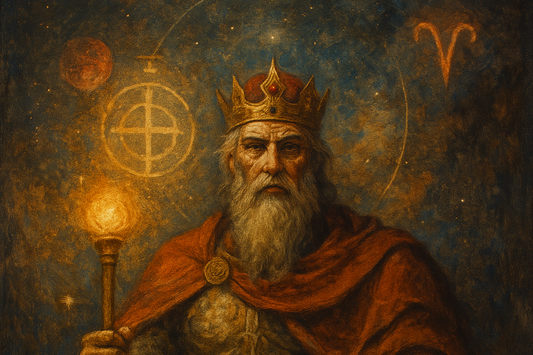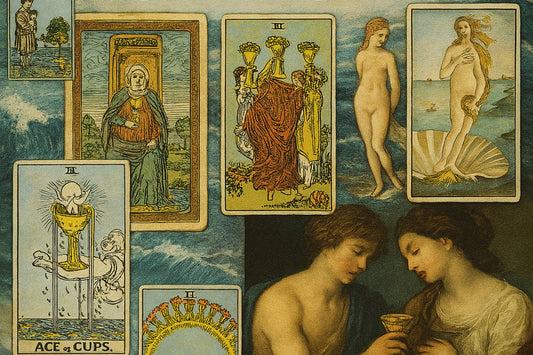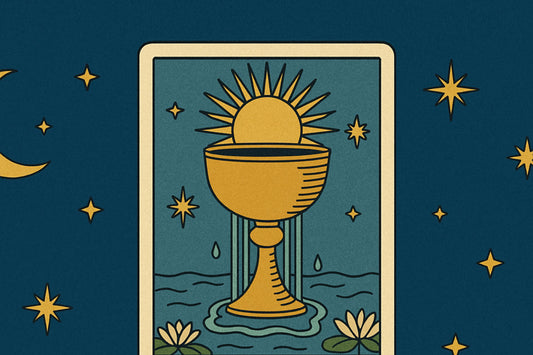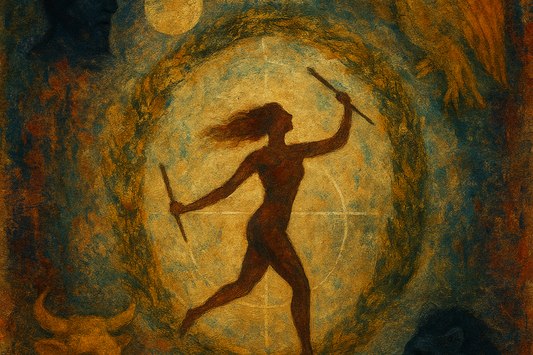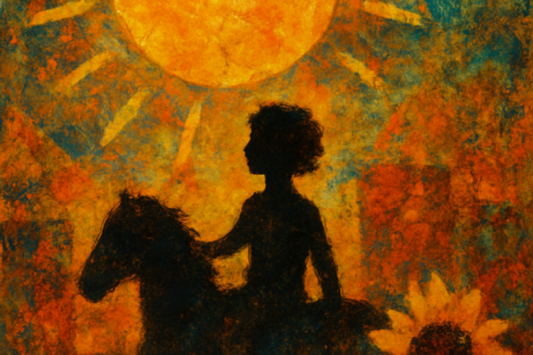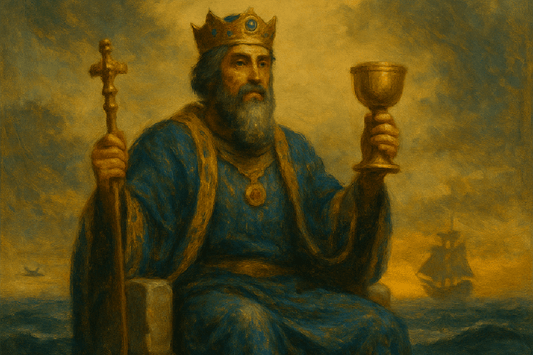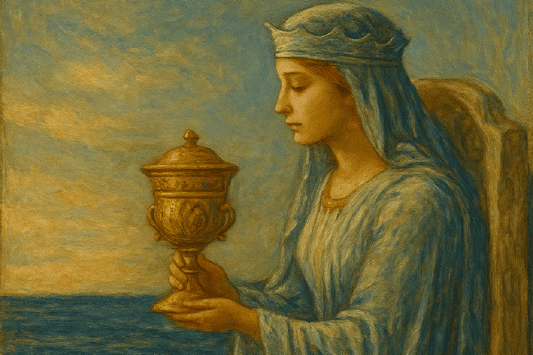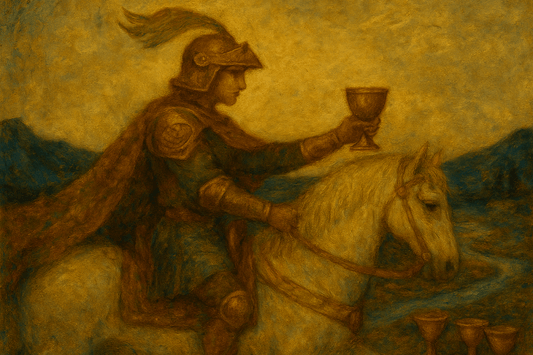The Chariot in Tarot: Willpower, Movement and the Path of Triumph
Tarot AccessoriesTable of Contents
- TL;DR: The Chariot Quick Reference
- The Archetype of The Chariot in the Tarot
- Symbolism and Imagery of The Chariot
- Meaning of The Chariot in a Tarot Reading
- Reversed Meaning of The Chariot in a Tarot Reading
- The Evolution of The Chariot Throughout History
- Numerology and the Number Seven in Tarot
- Astrological Resonance of The Chariot
- FAQs About The Chariot in Tarot

TL;DR: The Chariot Quick Reference
Upright: Victory, willpower, self-mastery, forward motion, alignment, focus, drive, control, triumph, momentum, emotional discipline, integration of duality
Reversed: Scattered energy, loss of direction, stagnation, internal conflict, forced movement, emotional avoidance, lack of discipline, impulsivity, resistance to growth, misalignment
The Archetype of The Chariot in the Tarot
The Chariot is the threshold between force and finesse. It is the will, concentrated - not brash or chaotic, but ordered and directed. This is the card of sacred motion: the capacity to steer one’s life with integrity, despite internal tension or external complexity.
Archetypally, The Chariot represents the part of the psyche that seeks movement after containment - the force that drives the journey outward after the inward gestation of The Lovers. It is the Hero, stepping into the world not as wanderer but as agent. This is a card of control, but not repression - of discipline, not domination.
When The Chariot appears in a reading, it marks a moment where clarity and control must be reclaimed. Not control over others - but over one’s own impulses, fears, and distractions. It demands focused momentum - a commitment to movement that is aligned, not reactive.
On The Fool’s journey, The Chariot marks the passage into self-direction. The sacred fire has been lit - and now it must be steered.
Related Cards to Explore
The Fool in Tarot: Sacred Trust, Archetypal Innocence and New Beginnings
The Magician in Tarot: Manifestation, Will and the Power to Begin
The High Priestess in Tarot: Inner Knowing, Mystery and Sacred Stillness
The Empress in Tarot: Fertility, Creation and Archetypal Abundance
The Emperor in Tarot: Structure, Sovereignty and the Archetype of Order
The Hierophant in Tarot: Tradition, Transmission and Sacred Order
The Lovers in Tarot: Union, Choice and Sacred Alignment
Symbolism and Imagery of The Chariot
In the Rider-Waite-Smith deck, The Chariot depicts a crowned figure standing within a square chariot - not holding reins, but composed, still, sovereign. The charioteer wears a suit of armour adorned with alchemical symbols, moons upon the shoulders, and a star crown above the head - indicating cosmic alignment and inner discipline.
Beneath the chariot sit two sphinxes - one black, one white - representing opposing forces. They are not harnessed. They respond to will, not rope. Their direction must be held internally - by presence, not pressure. Their tension reflects duality: light and shadow, conscious and unconscious, instinct and logic.
The city lies behind. The road ahead is unmarked. The canopy of stars reminds us that this journey is both celestial and earthly. The square of the chariot represents structure. The four pillars signal foundation. The wheels are implied, not turning - movement is pending the integration of purpose.
Every line in this image whispers: move - but only from the centre.
Meaning of The Chariot in a Tarot Reading
In a reading, The Chariot often arrives at moments of testing. When you must act - but act from clarity. It suggests that motion is necessary - but not any motion will do. The Chariot insists that your energy be gathered, your forces aligned, your heart checked.
This is the card of movement, but also of mental and emotional discipline. It asks:
- What are you driving toward?
- Who is holding the reins - your ego or your essence?
- What needs to be released in order for the wheels to turn?
The Chariot in a spread may indicate physical travel, launching a project, seizing momentum, or finally taking action on something long considered. But none of that matters if it’s not aligned.
The card says: your power is real - but only if you claim it consciously.
Reversed Meaning of The Chariot in a Tarot Reading
Reversed, The Chariot reveals fragmentation. You may feel pulled in multiple directions - by fear, habit, conflicting desires, or outside influence. The sphinxes pull apart. The wheels spin without traction.
This is the moment where movement becomes misalignment - where the act of “doing something” becomes a distraction from doing the right thing.
It may signal:
- A lack of emotional integration
- Rebellion against necessary structure
- Impatience, or movement born from panic
Alternatively, The Chariot reversed can point to passivity - the inability or refusal to move, even when the way forward is clear. In both extremes - rushing or freezing - the core issue is the same: your will is not aligned with your truth.
This card reversed asks: what are you trying to outrun - and what would happen if you stopped and listened?
The Evolution of The Chariot Throughout History

The Chariot archetype predates tarot. In myth and sacred art, the chariot is often associated with heroes and gods - from Apollo driving the sun across the sky, to Krishna guiding Arjuna’s chariot in the Bhagavad Gita. The chariot is more than a vehicle - it is the symbol of divine agency, the disciplined self, and the soul navigating the world.
Early Tarot Appearances – Visconti and Marseille

In the 15th-century Visconti Di Modrone and Visconti-Sforza tarrochi decks, The Chariot was typically portrayed as a regal or noble figure - sometimes female - riding a cart drawn by horses. The image suggested triumph, sovereignty, or martial virtue, and reflected the pageantry of the time.
By the Marseille era, The Chariot becomes a male warrior holding a sceptre, crowned and armoured, pulled by two horses. The horses often face in different directions - reinforcing the tension of conflicting drives. The figure no longer holds reins. He has to direct with presence alone.
Christian Overlays and Symbolic Distortion
During the Christianisation of tarot, The Chariot became a symbol of moral victory - the soul triumphing over the base instincts. The card retained martial imagery, but its meaning shifted toward discipline, chastity, and submission of will to divine law.
The horses became not just forces - but virtues or sins to be tamed. The charioteer became a moral ideal.

Golden Dawn and Esoteric Interpretation
The Golden Dawn assigned The Chariot to Cancer, ruled by the Moon - a bold move that placed emotional intelligence at the centre of victory. It was mapped to Path 18 on the Tree of Life, connecting Geburah (Severity) and Binah (Understanding).
The Chariot became not a worldly triumph, but a spiritual container - the Merkavah, the mystic chariot of vision and ascension. Its victory was not over others - but over ego.
The Chariot in the 1900s and 2000s

In the Rider-Waite-Smith deck, the horses become sphinxes. The reins vanish. The figure is no longer masculine or martial - but spiritual, composed, serene.
The tension between opposing drives is made explicit. The message is internalised. No longer about war - this Chariot is about self-mastery, not conquest.
In Crowley’s Thoth deck, the Chariot is even more alchemical - pulled by four beasts representing the fixed signs of the zodiac, bearing the Holy Grail, enclosed in a crystalline cube. Here, the victory is one of transformation and purity - the ego dissolved, the self clarified.
Modern Decks
Contemporary decks interpret The Chariot as everything from a literal road trip to deep spiritual warfare. Some return to the classical image - others explore abstract representations of movement, direction, and agency.
But one theme remains: power through integration. The charioteer must always integrate polarities - masculine and feminine, will and intuition, light and shadow - or risk the entire vehicle tearing apart.
Numerology and the Number Seven in Tarot
In the tarot, the seven is the seeker’s number - the call to act, but with spiritual motive. It introduces friction - the test of whether your movement is impulsive or aligned.
In the Major Arcana, Seven follows The Lovers - choice - and precedes Strength - inner containment. This positions The Chariot as the test of what you do with what you choose. It is the bridge between emotional truth and disciplined follow-through.
Seven’s lesson: will alone is not enough. It must be aligned with heart, body, and soul.
Astrological Resonance of The Chariot
The Chariot is ruled by Cancer, a cardinal water sign, governed by the Moon. This might seem at odds with the card’s driven, active feel - but Cancer’s motion is not impulsive. It is protective, strategic, and deeply emotional.
The crab moves sideways - not in straight lines - but always with purpose. Cancer teaches us that emotional intelligence, when contained and honoured, becomes spiritual force.
The Moon adds layers of inner awareness, intuition, and reflective perception. The Chariot is not about forward motion at any cost - it is movement from a place of deep inner clarity.
FAQs About The Chariot in Tarot
What does The Chariot mean in a love reading?
In love, The Chariot can suggest progress - a relationship advancing with purpose. It may also indicate emotional discipline is required. Are you moving together - or are unresolved dynamics pulling you in separate directions?
Is The Chariot a yes or no card?
Yes - but conditionally. The Chariot says yes if you are aligned, focused, and willing to hold yourself accountable. Victory is available, but not without clarity and willpower.
What does The Chariot mean when reversed?
Reversed, The Chariot signals misalignment. You may be pushing forward without clarity, pulled by fear, or resisting necessary action. The reversal suggests internal conflict is blocking external motion - and only integration can resolve it.
What archetype does The Chariot represent?
The Chariot is the archetype of the Integrated Warrior - the one who has harnessed instinct, aligned emotion, and committed to movement. Not the conqueror - but the sovereign-in-motion.


